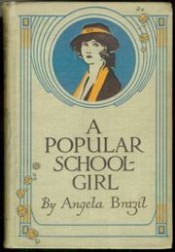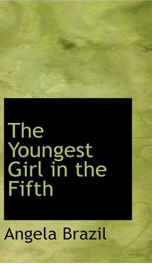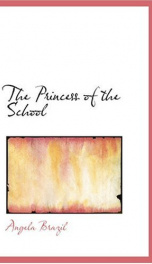Brazil Angela

Angela Brazil (pronounced "brazzle") (November 30, 1868 – March 13, 1947) was one of the first British writers of "modern" School Girls' Stories genre, written from the characters' point of view and intended primarily as entertainment rather than moral instruction. In the first half of the twentieth century she published nearly 50 books of girls' fiction, the vast majority being boarding school stories. She also published numerous short stories in magazines. Her books were commercially successful, were widely read by adolescent girls, and influential upon their readers. While interest in girls school stories waned after World War II, her books remained popular until the 1960s. They were seen as disruptive and a negative influence on moral standards by some figures in authority during their height of popularity, and in some cases were banned by headmistresses in British girls' schools. While her stories have been much imitated in more recent decades, and many of her motifs and plot elements have since become cliches, or the subject of parody, in her earlier publications they were innovative. Brazil made a major contribution to changing the nature of fiction for girls. She presented a young female point of view which was active, aware of current issues and independently minded; recognised adolescence as a time of transition, and accepted girls as having common interests and concerns which could be shared and acted upon. She was born in Preston, Lancashire in 1869, during the Victorian era. [1] She was the youngest child of Clarence Brazil, a mill manager, and Angelica McKinnel, the daughter of the owner of a shipping line in Rio de Janeiro, who had a Spanish mother. She was the youngest of four siblings including sister Amy, and two brothers, Clarence and Walter.[2] Her father Clarence was distant, seldom involved himself in his children's affairs, and saw himself primarily as a provider for the material well being of the family and responsible for ensuring the children was appropriately schooled in religious tradition.[3] She was primarily influenced by her mother, Angelica, who had suffered during her Victorian English schooling, and was determined to bring up her children in a liberated, creative and nurturing manner, encouraging them to be interested in literature, music and botany, a departure from the typical distant attitude towards children adopted by parents in the Victorian era. Angela was treated with great affection by her sister Amy from an early age, and Amy effected an immense, perhaps dominating influence on Angela throughout her life.[4] The family moved around the mill towns of south-east Lancashire, following her father's work opportunities. They lived in Manchester and Bolton, before settling in Bury.[5] She commenced her education at age four at Miss Knowle's Select Ladies School in Preston, but lasted only a half day. Having been brought up to express herself freely, she shocked the younger Miss Knowles by removing the teacher's hair pins while sitting on her knee, an action little in keeping with the strict disciplinarian ethos of the school.[6] She was enrolled in The Turrets in Wallasey.[5] She was briefly at Manchester Secondary School and finally at Ellerslie, a fairly exclusive girls' school, where she boarded in her later adolescence.[5] Her memories of her own schooldays were her most treasured, and she retained aspects of that period of her life into her adult years: [1] "To be able to write for young people depends, I consider, largely upon whether you are able to retain your early attitude of mind while acquiring a certain facility with your pen. It is a mistake ever to grow up! I am still an absolute schoolgirl in my sympathies"[7] Her post school education was at Heatherley School of Fine Art in London, where she studied with her sister Amy. It is possible she took a position as a governess, but mostly lived with her family. After her father’s death, in 1899, the family moved to the Conwy valley, and she traveled with her mother in Europe.[5] She first starting writing at age 10, producing a magazine with her close childhood friend Leila Langdale, which was modelled on Little Folks, a children's publication of the time she was very fond of. The two girl's 'publication' included riddles, short stories and poems. Both girls wrote a serial within their magazine, Brazil's was called Prince Azib. Later in life Brazil published in Little Folks.[8] She began writing seriously for children in her 30s. Her first school story was The Fortunes of Phillipa, which was based on the experiences of her mother. It was not published until 1906, [1] and her first published children’s novel was A Terrible Tomboy (1904). [9] She spent most of her time with her mother until her death, and thereafter with her elder sister Amy, and brother Walter. She had only two major friendships outside the family circle, one of which started in her school days and the other in her 30s. Both friends were schoolgirls when the friendships first commenced.[10] She moved to 1 The Quadrant, Coventry in 1911, with her brother and they were joined by her sister Amy upon their mother's death in 1915[5] Brazil became a well known figure in the local area. [11] She was well known in Coventry high society as a hostess and threw parties for adults, with a greater number of female guests, at which children's food and games were featured. She had no children of her own but also hosted many parties for children. [11] She read widely and collected early children's fiction; her collection is now in Coventry library. She took great interest in local history and antiquities, and also involved herself in charity work. [11] She was an early conservationist, taking an interest in both the preservation of land and monuments, worked for the City of Coventry Cathedral, the Y.W.C.A and was a founding member of the City Guild.[12] She never married. She was quite late in taking up writing, developing a strong interest in Welsh mythology, and at first wrote a few magazine articles on mythology and nature – due most likely to spending holidays in a cottage in Wales. He first publication was a book of four children's plays entitled The Mischievous Brownie. Written in Wales, and published in 1899 by T.W. Paterson of Edinburgh, the plays featured fairies, ogres and enchantments. Family and friends encouraged her to write a novel for an adult audience, but she had already set her heart on writing for children. She began work on her first full length tale for children, The Fortunes of Phillipa in the same year, after her Father's death. [13] Her first published novel was A Terrible Tomboy (1905), but this was not strictly a school story.[11] The story was autobiographical, with Brazil represented as the principal character Peggy, and her friend Leila Langdale, appearing as Lilian.[14] It was an early success for Brazil, and did well in the United States, perhaps as a result of the popularity of Tomboy stories, which had grown in popularity in that country since the mid 19th Century. [11] Her long sequence of school stories did not commence until the publication of her second novel The Fortunes of Phillipa (1906). The novel was based on her mother, Angelica Brazil, who had grown up in Rio de Janeiro and attended an English Boarding school at the age of 10, finding the English culture, school life and climate confronting.[15] The Fortunes of Phillipa was an instant success, and Brazil soon received commissions to produce similar work. In total she published 49 novels about life in boarding schools, and approximately 70 short stories, which appeared in magazines. Her average production of these tales was two novels and five short stories each year.[16] Her fifth novel, Bosom Friends: A Seaside Story (1910) was published by Nelson's, but subsequent books were all published by Blackie and Sons.[17] Blackie and Sons sold three million copies of her novels.[18] Her most popular school story novel, The Nicest Girl in The School (1909) sold 153,000 copies.[19] By 1920 the school story was the most popular genre for girls. [18] Angela Brazil is seen as the first writer of girls' school story fiction who wrote stories from the point of view of the pupils and whose stories were mostly intended to entertain readers, rather than instruct them on moral principals. She intended to write stories that were fun and included characters who were ordinary people. She wrote for girls gaining a greater level of freedom in the early 20th century and intended to capture their point of view.[20] Unlike many of her successors, Brazil never wrote a series of book set in a particular school, although there are three pairs of books among her 46 full-length school stories: A Fortunate Term/Monitress Merle, At School with Rachel/St Catherine’s College and The Little Green School/Jean’s Golden Term. Monitress Merle also has a substantial character overlap with The Head Girl at the Gables and A Fortunate Term has a slight connection with The Girls of St Cyprian. Most of her novels present new characters, a new school and a new scenario, although these are frequently formulaic, especially in the books written later in her career.[18] Her schools usually have between 20 and 50 pupils and so are able to create a community which is an extended family, but also of sufficient size to function as a kind of micro state, with its own traditions and rules.[21] The schools tend to be situated in picturesque circumstances, being manors, having moats, being built on clifftops or on moors and the style of teaching is often progressive, including experiments in self expression, novel forms of exercise, and different social groups and activities for the girls.[22] The narrative focuses on the girls, who tend to be between 14 and 15. Although they are high spirited and active, they are not eccentric or directly conflicting with social norms, as had been the case with Tomboy fiction. They are adolescents, shown as being in a normal period of transition in their lives, with a restlessness that tends to expressed by minor adventures such as climbing out of dormitory windows at night, playing pranks on one another and their teachers and searching for spies in their midst. They also typically develop their own behavioural codes, have a slang or secret language, which is exclusive to the school.[23]
do you like this author?
What readers are saying
What do you think? Write your own comment on this book!
write a commentWhat readers are saying
What do you think? Write your own comment on this author!
write a commentBook list

The Girls of St. Cyprian'sA Tale of School Life
Series:
Unknown
Year:
Unknown
Raiting:
4/5
Show more
add to favoritesadd In favorites
Book list

The Girls of St. Cyprian'sA Tale of School Life
Series:
Unknown
Year:
Unknown
Raiting:
4/5
Show more
add to favoritesadd In favorites

The Jolliest Term on RecordA Story of School Life
Series:
Unknown
Year:
Unknown
Raiting:
4.5/5
Show more
add to favoritesadd In favorites

The Leader of the Lower SchoolA Tale of School Life
Series:
Unknown
Year:
Unknown
Raiting:
5/5
Show more
add to favoritesadd In favorites

The Nicest Girl in the SchoolA Story of School Life
Series:
Unknown
Year:
Unknown
Raiting:
3.5/5
Show more
add to favoritesadd In favorites

The New Girl at St. Chad'sA Story of School Life
Series:
Unknown
Year:
Unknown
Raiting:
3.5/5
Show more
add to favoritesadd In favorites

The Youngest Girl in the Fifth
Series:
Unknown
Year:
Unknown
Raiting:
3/5
Angela Brazil (1868-1947) was the first of the British writers of "modern" School Girls' Stories genre - written from the characters' point of view. Along with her sister Amy, Angela then studied at Heatherley School of Fine Art in London. She was quite late in taking up writing, developing a strong interest in Welsh mythology, and at first wrote a few magazine articles on mythology and nature. It was possibly thanks to her sister Amy that she finally began work on a novel at the age of 35. Exceptionally with respect to many of her contemporaries writing in this vein, Brazil did not write any books in a series - each stood on its own with different characters every time. These were considered to deal accurately and sympathetically with the highs and lows in the lives of middle-class schoolgirls, including the tangle of emotional friendships. Her works include: The New Girl at St. Chad's (1911), For the Sake of the School (1915), The Luckiest Girl in the School (1916) and The Jolliest School of All (1922). --This text refers to the Paperback edition.
Show more
add to favoritesadd In favorites

A Popular Schoolgirl
Series:
Unknown
Year:
Unknown
Raiting:
2.5/5
Hereward s burst of eloquence was brought to an abrupt end by the violent onslaught of a fox-terrier puppy which flung itself upon him and began to worry his ankles with delighted yelps of appreciation. --This text refers to an alternate Paperback edition.
Show more
add to favoritesadd In favorites

A Patriotic Schoolgirl
Series:
Unknown
Year:
Unknown
Raiting:
2.5/5
Angela Brazil (1868-1947) was the first of the British writers of "modern" School Girls' Stories genre - written from the characters' point of view. Along with her sister Amy, Angela studied at Heatherley School of Fine Art in London, but she was quite late in taking up writing, developing a strong interest in Welsh mythology, and at first wrote a few magazine articles on mythology and nature. It was possibly thanks to her sister Amy that she finally began work on a novel at the age of 35. Exceptionally with respect to many of her contemporaries writing in this vein, Brazil did not write any books in a series - each stood on its own with different characters every time. These were considered to deal accurately and sympathetically with the highs and lows in the lives of middle-class schoolgirls, including the tangle of emotional friendships. Her works include: The New Girl at St. Chad's (1911), For the Sake of the School (1915), The Luckiest Girl in the School (1916) and The Jolliest School of All (1922). --This text refers to the Paperback edition.
Show more
add to favoritesadd In favorites

The Nicest Girl in the School
Series:
Unknown
Year:
Unknown
Raiting:
3.5/5
Angela Brazil (1868-1947) was the first of the British writers of "modern" School Girls' Stories genre - written from the characters' point of view. Along with her sister Amy, Angela then studied at Heatherley School of Fine Art in London. She was quite late in taking up writing, developing a strong interest in Welsh mythology, and at first wrote a few magazine articles on mythology and nature. It was possibly thanks to her sister Amy that she finally began work on a novel at the age of 35. Exceptionally with respect to many of her contemporaries writing in this vein, Brazil did not write any books in a series - each stood on its own with different characters every time. These were considered to deal accurately and sympathetically with the highs and lows in the lives of middle-class schoolgirls, including the tangle of emotional friendships. Her works include: The New Girl at St. Chad's (1911), For the Sake of the School (1915), The Luckiest Girl in the School (1916) and The Jolliest School of All (1922). --This text refers to an alternate Paperback edition.
Show more
add to favoritesadd In favorites
What readers are saying
What do you think? Write your own comment on this author!
write a commentif you like Brazil Angela try:
readers also enjoyed
What readers are saying
What do you think? Write your own comment on this author!
write a commentGenre
if you like Brazil Angela try:
readers also enjoyed
Do you want to read a book that interests you? It’s EASY!
Create an account and send a request for reading to other users on the Webpage of the book!


